
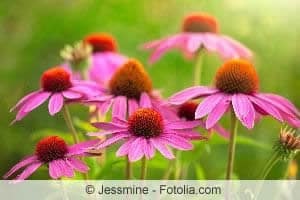
Table of contents
- Origin
- Look
- sowing
- Location
- Plant
- Pour
- Fertilize
- Cut
- hibernate
- multiply
- diseases and pests
- Summary
- frequently asked Questions
- Worth knowing about Crimson Coneflower shortly
A wonderful feast for the eyes is the Echinacea purpurea, also known as the purple coneflower. The Echinacea purpurea belongs to the late bloomers and enchants the garden, especially in autumn, with its purple flowers. The hedgehog's head, which usually appears in a darker red, is typical of this plant. The flowers themselves shine in a rich crimson.
Origin
Echinacea purpurea originally came from North America, where it still grows today. In Europe the plant is cultivated as an ornamental plant and often appears in German gardens as a late bloomer.
Look
The appearance of the purple coneflower is particularly wonderful when planted in groups. In favorable conditions, the purple coneflower can reach a height of 60 to 180 cm. The plant can be recognized by the base of the flower, which is cone-shaped and slightly curved. It is reminiscent of a hedgehog, which is where the name hedgehog head comes from. In terms of color, the base of the flower can be seen in a darker and richer red. The flowers are well described as long tubular flowers that appear very narrow-leaved. The leaves of Echinacea purpurea are also elongated and lanceolate. Often it can be seen that the petals hang, which does not seem strange given the length of 2 to 4 cm.
sowing
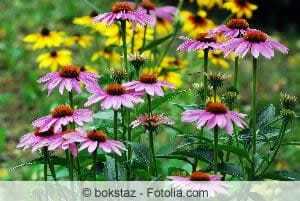
Sowing takes place in the months of April to May. Sowing the plant in a pot is not advisable as it can reach a very considerable height of 180 cm. However, it is not impossible to cultivate Echinacea purpurea in a pot. The planting distance is 30 to 40 cm so that the roots can spread well.
Location
As the name suggests, the coneflower needs a lot of sun so that it can show a good bloom. However, Echinacea purpurea can also grow and thrive in semi-shade. However, in this case a reduced flowering can be seen. The soil should be well drained and rich in humus. An optimal location is also near the water. So if you have a pond in your garden, don't hesitate to choose a spot near the pond.
Plant
Echinacea purpurea is best planted outdoors in a sunny spot from April to May.
Pour
The Echinacea purpurea is very undemanding and does not require a lot of care. If the plant is planted near water, it does not necessarily need to be watered. However, if the weather seems too dry, you should give the plant some water. Be careful not to keep the soil too moist.
Fertilize
You should be careful with fertilizing the coneflower. If you fertilize the plant too much, it will grow quickly, but this will weaken the plant too much. The result could be twisting and thus the death of the Echinacea purpurea. It is advisable to use compost or a complete fertilizer during the flowering period. A single application is often sufficient to supply the Echinacea purpurea with nutrients.
Cut
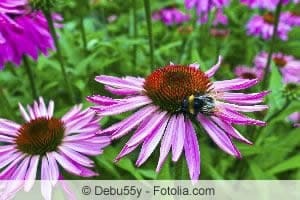
The flowering period is relatively short for Echinacea purpurea and only takes place from August to October. After the flowering period, you should cut the plant back to about a hand’s breadth above the ground. By cutting back, the Echinacea purpurea can show its full bloom again next year.
hibernate
Echinacea purpurea does not need a lot of attention to hibernate. If you prune coneflowers right after flowering, only a small size will remain, and it won't grow much over the winter either. You can cover the plant with some foliage when temperatures drop very low. As a rule, however, Echinacea purpurea can survive the winter unnoticed.
multiply
Echinacea purpurea is a perennial plant that is propagated by root division every few years. The roots have a strong growth, so you should divide them at least every 3 years. If you want to multiply the Echinacea purpurea without root division, the only option is to sow again.
Tip:
Echinacea purpurea reproduces vegetatively. A good tip, however, is to propagate the plant using root cuttings, which is considered more productive.
diseases and pests
Actually, the Echinacea purpurea is very robust and requires little maintenance. However, if the soil is too impermeable, waterlogging can occur, which can cause significant damage to the plant. Excessive nutrient uptake weakens the plant and can cause the stem to snap. Should this happen, it is advisable to cut back the plant immediately. Also refrain from further fertilization measures in the following flowering period. If you see spots on the leaves, this can indicate a fungal disease. If you spot spots on the leaves, you should remove them as soon as possible and also use a fungicide to prevent reinfestation.
Summary
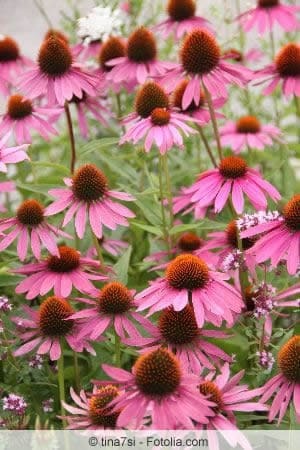
Echinacea purpurea is a late bloomer that brightens up the garden with a crimson color from August to October. Below you will find an overview of all the important properties of the plant:
- Growth height 60 to 180 cm
- Flowers mostly pendulous
- easy maintenance
- hardy
- permeable soil required preferably near water
frequently asked Questions
The full beauty of the plant occurs when you plant coneflowers in heaps. You can combine the Echinacea purpurea with globe thistles, larkspurs, coneflowers, sage, monkshood, asters, goldenrod or the fine ray aster. The blaze of color comes out best in a separate bed.
The sun hat is very suitable for decorating the table in the living room. Due to the size that the coneflower grows, you can easily cut the plant during the flowering period and tie it as a bouquet. Be sure to add some nutrients to the water.
Once the plant has a disease present, you need to treat the plant. A fungicide is most effective at killing the bacteria or fungus. Alternatively, you can also fertilize the plant with nettle manure and spray the plant with it. However, if the disease persists, treatment with a fungicide is advised as the disease can spread to other plants.
Worth knowing about Crimson Coneflower shortly
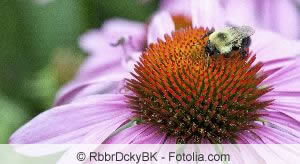
other names
The purple coneflower belongs to the daisy family (Asteraceae). Other German names for Rudbeckia purpurea are real sun hat, purple sun hat, purple cone flower, purple hedgehog head, red sun hat or red sunflower.
Care
- Unlike the yellow coneflower (Rudbeckia fulgida) the Echinacea purpurea is rather a very short-lived plant.
- If you want lush borders, you should sow the red coneflower regularly in spring.
- We recommend sowing at around 15 °C, for example in one mini greenhouse.
Cut
- Cut back to a hand's breadth above the ground immediately after flowering.
- Otherwise it could happen that the plant spends too much time developing seeds.
- A regular rejuvenation can be done by a division in spring.
Application in medicine
- The perennial from the American continent is also used in medicine.
- Originally, the purple cone flower was native to both North and South America.
- From there it used to be brought to Europe from wild collections.
- The medicinal herb is now cultivated worldwide.
The fresh or dried above-ground parts of the purple coneflower (Echinacea purpurea herba). In addition, the plant sap obtained from the flowering above-ground parts of the plant and, more rarely, the root (Echinacea purpurea radix) used for medicinal purposes.
Other areas of application
Due to the germ-repellent effect, purple coneflower herb medications are taken internally used in chronic and recurring infections of the respiratory tract and the efferent urinary tract Other common uses for purple coneflower are colds and flu. The purple coneflower herb is said to increase the body's defenses. External use is also possible, for example for poorly healing, superficial wounds, small injuries, ulcers and skin inflammation. By the way: Purple coneflowers are also available for horses, for example, as additional feed to strengthen their immune system.
 garden editorial
garden editorial I write about everything that interests me in my garden.
Find out more about perennial lexicon

Lenten rose, Helleborus orientalis: 13 tips for care
The spring rose is one of the few plants that also blooms in winter. In order for the plant to bear its colorful flowers, however, certain requirements regarding location and care must be met.
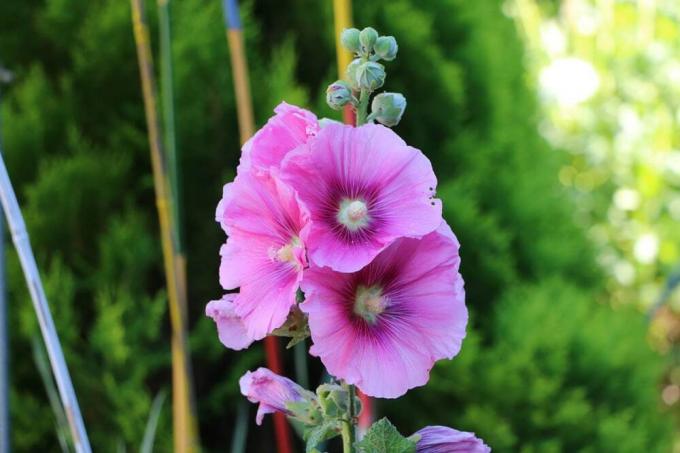
13 hardy perennials for sunny locations
Hardy perennials have a particularly long lifespan and allow sunny locations to bloom beautifully. At the beginning of each season, the perennial plants thrive anew and enchant the garden with a colorful world of flowers. Due to the large number of varieties, you have many design options.

Tree peony, Paeonia suffruticosa: Care from A - Z
With its large, eye-catching and colorful flowers, it is one of the noblest representatives of the peonies, the tree peony. Its natural home is China, which is why it is often referred to as the imperial flower. It presents its beautiful flowers between April and June.

Fat man: Care from A-Z | Planting distance and propagation
The shady areas under trees are neglected in many gardens, because only a few plants feel comfortable here. One of these few plants is the fat man (bot. Pachysander terminalis).
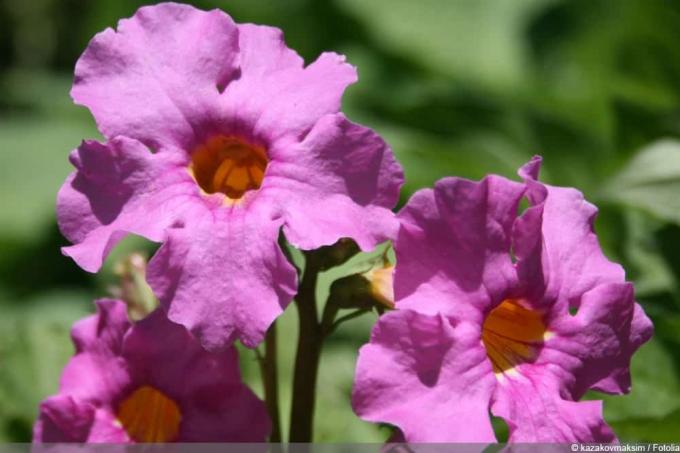
Flowering Fern: 14 Annual and Hardy Species | Care Instructions
A green fern with its beautifully designed fronds is a feast for the eyes in itself. It doesn't have to bloom to inspire. If flowers do appear, a garden gloxinia is actually at work. This flower is often incorrectly referred to as a blooming fern.
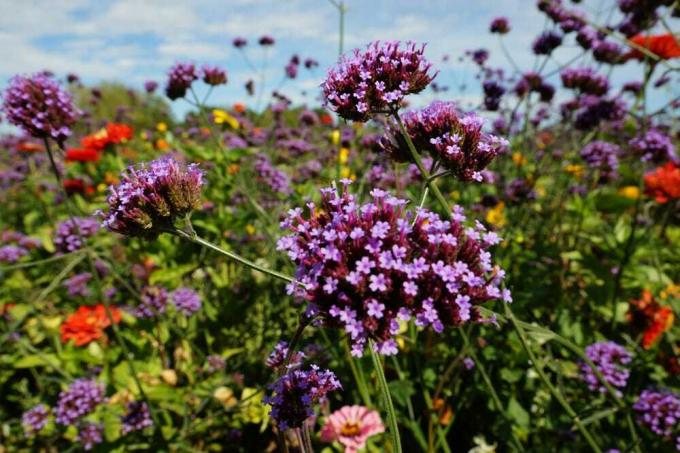
Patagonian Verbena, Verbena Bonariensis - Care Guide
Summer, sun, garden, flowers - here the Patagonian verbena is in its element, with fairy-like lightness purple flowers float on filigree stems above the flower bed and also attract all the butterflies area. Romantic gardeners love the effect of Verbena bonariensis, every gardener loves it Vigorous growth with the lowest maintenance requirements - verbena is a herb that benefits every garden brings.



